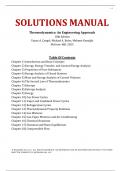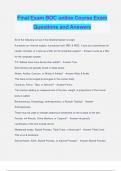1-1
SOLUTIONS MANUAL
Thermodynamics: An Engineering Approach
10th Edition
Yunus A. Çengel, Michael A. Boles, Mehmet Kanoğlu
McGraw-Hill, 2023
Table Of Contents
Chapter 1) Introduction and Basic Concepts
Chapter 2) Energy, Energy Transfer, and General Energy Analysis
Chapter 3) Properties of Pure Substances
Chapter 4) Energy Analysis of Closed Systems
Chapter 5) Mass and Energy Analysis of Control Volumes
Chapter 6) The Second Law of Thermodynamics
Chapter 7) Entropy
Chapter 8) Entropy Analysis
Chapter 9) Exergy
Chapter 10) Gas Power Cycles
Chapter 11) Vapor and Combined Power Cycles
Chapter 12) Refrigeration Cycles
Chapter 13) Thermodynamic Property Relations
Chapter 14) Gas Mixtures
Chapter 15) Gas-Vapor Mixtures and Air-Conditioning
Chapter 16) Chemical Reactions
Chapter 17) Chemical and Phase Equilibrium
Chapter 18) Compressible Flow
© MCGRAW HILL LLC. ALL RIGHTS RESERVED. NO REPRODUCTION OR D ISTRIBUTION WITHOUT THE PRIOR
WRITTEN CONSENT OF M CGRAW HILL LLC.
, 1-2
Chapter 1
INTRODUCTION AND BASIC CONCEPTS
PROPRIETARY AND CONFIDENTIAL
This Manual is the proprietary property of McGraw Hill LLC and protected by copyright and other state and federal laws.
By opening and using this Manual the user agrees to the following restrictions, and if the recipient does not agree to these
restrictions, the Manual should be promptly returned unopened to McGraw Hill LLC: This Manual is being provided only
to authorized professors and instructors for use in preparing for the classes using the affiliated textbook. No other use or
distribution of this Manual is permitted. This Manual may not be sold and may not be distributed to or used by any student
or other third party. No part of this Manual may be reproduced, displayed or distributed in any form or by any means,
electronic or otherwise, without the prior written permission of McGraw Hill LLC.
CYU - Check Your Understanding
CYU 1-1 ■ Check Your Understanding
CYU 1-1.1 Choose the wrong statement about the first law of thermodynamics.
(a) During an interaction, energy can change from one form to another.
(b) During an interaction, the total amount of energy remains constant.
(c) Energy can be destroyed but it cannot be created.
(d) Energy is a thermodynamic property.
(e) A system with more energy input than output will gain energy.
Answer: (c) Energy can be destroyed but it cannot be created.
CYU 1-1.2 Which statement best expresses the second law of thermodynamics?
(a) The temperature of a well-sealed room increases when a fan in the room is turned on.
(b) A cup of cool coffee in a warm room never gets hot by itself.
(c) Heat is generated when there is friction between two surfaces.
(d) A household refrigerator supplies heat to the kitchen when operating.
(e) A person who has a smaller energy input than output will lose weight.
Answer: (b) A cup of cool coffee in a warm room never gets hot by itself.
CYU 1-2 ■ Check Your Understanding
CYU 1-2.1 Which of the following is not a correct unit for work?
© MCGRAW HILL LLC. ALL RIGHTS RESERVED. NO REPRODUCTION OR D ISTRIBUTION WITHOUT THE PRIOR
WRITTEN CONSENT OF M CGRAW HILL LLC.
, 1-3
(a)
(b) Nm
(c)
(d) kJ
(e) kWh
Answer: (a)
CYU 1-2.2 Using unit considerations, select the correct equations.
I. Mass = Force Acceleration
II. Work = Force Distance
III. Work = Power Time
IV. Density = Mass Volume
(a) I and II
(b) I and III
(c) II and III
(d) I, II, and III
(e) II, III, and IV
Answer: (c) II and III
CYU 1-2.3 What is the weight of 10 kg?
(a) 10 N
(b) 10 lbf
(c) 9.8 N
(d) 98 N
(e) 322 lbf
Answer: (d) 98 N
since
CYU 1-3 ■ Check Your Understanding
CYU 1-3.1 Choose the wrong statement regarding systems and control volumes.
(a) The mass or region outside the system is called the surroundings.
(b) The real or imaginary surface that separates the system from its surroundings is called the boundary.
(c) The boundary has zero thickness.
(d) The boundary can neither contain any mass nor occupy any volume in space.
(e) The boundary of a system is fixed; it cannot move.
Answer: (e) The boundary of a system is fixed; it cannot move.
CYU 1-3.2 Choose the wrong statement regarding systems and control volumes.
(a) Both mass and energy can cross the boundary of a control volume.
(b) Mass cannot enter or leave a closed system but energy can.
(c) Mass can enter or leave an isolated system but energy cannot.
(d) The boundaries of a control volume can be real or imaginary.
(e) The volume of a closed system does not have to be fixed.
© MCGRAW HILL LLC. ALL RIGHTS RESERVED. NO REPRODUCTION OR D ISTRIBUTION WITHOUT THE PRIOR
WRITTEN CONSENT OF M CGRAW HILL LLC.
, 1-4
Answer: (c) Mass can enter or leave an isolated system but energy cannot.
CYU 1-4 ■ Check Your Understanding
CYU 1-4.1 Which properties are intensive?
I. Volume,
II. Density,
III. Temperature, C
IV. Pressure, kPa
(a) II and III
(b) III and IV
(c) I, II and III
(d) II, III, and IV
(e) I, II, III, and IV
Answer: (d) II, III, and IV
CYU 1-5 ■ Check Your Understanding
CYU 1-5.1 A tank contains 0.5 kg of a gas. What is the density (in ) and specific volume (in ) of the
fluid, respectively?
(a) 1, 0.5
(b) 0.5, 1
(c) 0.5, 2
(d) 2, 0.5
(e) 0.5, 0.5
Answer: (c) 0.5, 2
CYU 1-5.2 What is the specific volume of a fluid whose specific gravity is 1.25?
(a)
(b)
(c)
(d)
(e)
Answer: (d)
CYU 1-5.3 What is the specific weight of a fluid whose specific gravity is 1?
(a)
(b)
(c)
(d)
(e)
© MCGRAW HILL LLC. ALL RIGHTS RESERVED. NO REPRODUCTION OR D ISTRIBUTION WITHOUT THE PRIOR
WRITTEN CONSENT OF M CGRAW HILL LLC.





